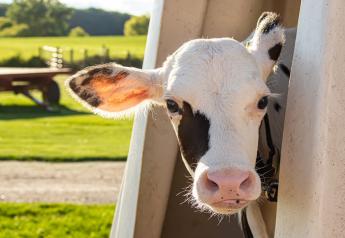6 On-Farm Priorities to Help Drive Success This Year

With the start of the new year comes the setting of resolutions for personal habits, behaviors and practices.
Dairies can and should do the same for their operations, according to Dr. Tom Overton, Professor of Animal Science at Cornell University, and Director of the Cornell PRO-DAIRY program. On a recent episode of the Cornell Cow Convos podcast, Overton shared his advice for on-farm priorities to drive success in the new year:
- Keep a handle on IOFC – Overton said income over feed cost (IOFC) generally represents half or more of a dairy’s total profitability, so monitoring it regularly – at least monthly, or even daily – is critical. He noted the two main factors affecting IOFC are:
- Component output – how much fat and protein the dairy is shipping per cow per day; and
- Feed efficiency – pounds of energy-corrected milk divided by dry matter intake for the herd.
Overton added that many dairies also do an excellent job of tracking feed costs in terms of cost-per-pound of TMR dry matter, but that metric typically only accounts for about 10% of variation in IOFC.
- Focus on forages – “Farms that focus on producing high-quality forages generally have the best income over feed cost,” stated Overton. They succeed by focusing on correct harvest maturity; harvest, packing, and sealing practices; silage management practices that minimize losses; and fiber digestibility, though the latter is often in the hands of Mother Nature. “An old rule of thumb that still holds up pretty well is that cows should be consuming 0.9-1.0% of their bodyweight as NDF from forage sources,” Overton shared.
- Feeding management matters – Developing a ration is one thing, but delivering it is another. Overton said the most successful herds are those that routinely monitor dry-matter intakes; utilize feed management software programs; and follow on-farm routines that ensure consistent feed-delivery times. “And I would be remiss if I didn’t mention one of my pet priorities – make sure the straw chop length and moisture are correct in the dry-cow diet to discourage sorting,” he advised.
- Stay in front of fresh-cow disorders – Overton advocates routine blood surveillance of fresh cows to detect subclinical disease and avoid fresh-cow “crashes.” Two key metrics to monitor are blood calcium and beta-hydroxybutyric acid (BHBA). “We’re not so concerned about the cows with low blood calcium on Day 1 – we find those actually turn out to be the really good-milking cows. But the cows that need attention are those that still are struggling to maintain blood calcium on Day 4,” he advised. In terms of subclinical ketosis, he recommended a goal of no more than 15-20% of fresh cows with BHBA levels above 1.2 mmol/L.
- Keep current on research – New discoveries continue to be made in dairy science, and Overton said it is important to stay informed and adjust management practices accordingly. As an example, he noted recent results by Cornell researchers indicating that feeding protein levels beyond requirements to fresh cows from 14-21 days can significantly increase milk production.
- Let cows be cows – Overton said he is not a fan of intense fresh-cow monitoring programs because they interfere with normal cow behavior through unnecessarily long lock-up times. “I don’t like to see cows locked up longer than 45 minutes, and less is better,” he stated. He said wearable monitoring technologies are allowing dairies to monitor cows without disrupting them, and narrow down the number of cows that need individual health attention. Remote activity monitoring also has been a game-changer in terms of reproduction, allowing for “amazing flexibility” in terms of pregnancy and lactation efficiency, herd replacement creation, and capitalizing on new opportunities like beef-on-dairy breeding.
Market indicators suggest 2024 could be another tough year for U.S. milk prices, so Overton said it will be important for dairy managers to do what they can to maintain and improve on-farm efficiency. “I hope our farms will be able to focus on these practices and stick to them,” he declared.
For more on nutrition, read:
- Interest Growing in Inulin for Lactating Dairy Rations
- Blame it on the Nutritionist
- How a Spreadsheet Can Help Simplify Calf TPI Tracking
- The Sweet Spot for Oral Calcium Supplementation
- Calf Microbial Supplements: Sorting out the “Pre,” the “Pro,” and the “Post”
- Can We Improve Colostrum Through Dam Nutrition?







